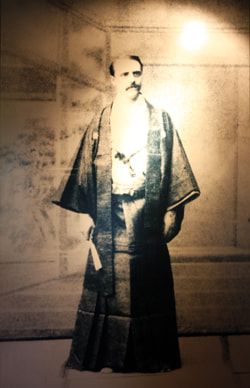
Josiah Conder (1852-1920) dressed in kimono
Conder was invited to Japan in 1877, as an architecture teacher at the Imperial College of Engineering (present-day Department of Architecture, the University of Tokyo) and an office advisor for the bureau of the building and repairs in the Ministry of the Engineering. He stayed in Japan until 1920, and designed many buildings, including Rokumeikan Palace. And he educated some famous architects, including Kingo Tatsuno and Kotaro Sakurai, and passed away at the age of 67 in Tokyo.
Q. I heard that GHQ requisitioned this building after the Second World War. Did the building escape the fire?
Matsui: It may be more accurate to say that the US Forces did not intentionally drop bombs on the building than that the building remained unburned. I heard that the US Forces accurately distinguished between targets and non-target buildings and conducted pinpoint bombings. Approximately 900 buildings were requisitioned after the war. Those were also non-target buildings. The bombings were carried out strategically from the beginning. The US Forces were fully informed about the buildings. I think the US Forces had obviously planned to requisition this building, so they did not drop bombs on it. They might think that they provoked Japanese people's antipathy if they destroyed Japanese cultures and emotional props. As Ruth Benedict pointed out in her book "The Chrysanthemum and the Sword," they judged that those things should be kept.
Q. I heard that the Iwasaki family lived in this house for some time even after the requisition.
The Canon Unit took over this resident in 1945. The Iwasaki family lived in a Japanese-style house, which was located behind the Western-style house, until 1949. At the end of the same year, they moved to Suehiro Farm in Tomisato-cho, Chiba Prefecture, which was formerly owned by them. It was a huge land, but most part of the farm was requisitioned after the war. The Iwasaki family had to relinquish the farm at the time. (continued in the lower column)

Hisaya Iwasaki and his family in the sun parlor
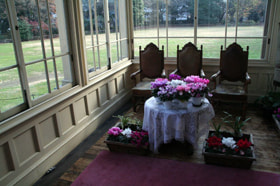
Present sun parlor
Hisaya Iwasaki was very interested in animals and agriculture. For example, Yanosuke Iwasaki, the second head of the family, founded Koiwai Farm in 1891. The name "Koiwai" was made up of initials of three cofounders - Gishin Ono (vice president of Nippon Tetsudo Company), Yanosuke Iwasaki (president of Mitsubishi) and Masaru Inoue (president of Tetsudo-cho). Hisaya Iwasaki, the third head of the family, succeeded to the farm and became its proprietor in 1899. Subsequently, Inoue and Ono died, and, after all, the Iwasaki family began to run the farm as an independently-owned business, which was not related to Mitsubishi. Hisaya was also involved in the business ever since the beginning, and purchased the land near Tomisato-cho to extend the farm. It is said that the Iwasaki family provided uncured ham to the Department of the Imperial Household. I think, in a sense, Hisaya was an agriculturist.
Q. Kyu-Iwasaki-tei Teien is a nationally-designated important cultural property and also a historic cultural heritage. Is it also acclaimed as a valuable building?
Although being a historic cultural heritage is the most important thing, Kyu-Iwasaki-tei is regarded as the greatest masterpiece by Conder who also designed Rokumei-kan at that time. From the very beginning Conder was especially good at designing private houses other than large public facilities. He was awarded the Soane Prize in housing design, which was one of the reasons why he was invited by the Japanese government. Kyu-Iwasaki-tei was designed when he was at the peak in his work, and, amid the historic background in which Western-style houses were built along with Japanese-style houses, Kyu-Iwasaki-tei was an architecture representing such an architectural style. (continued in the right column)
Therefore, the Agency for Cultural Affairs placed a high cultural value on it. Conder's design and the interior, which adopted so-called Jacobean Style, were also highly evaluated. Among buildings constructed in the Meiji Period, approximately nine structures, including Hyokei-kan at Tokyo National Museum and Sougakudou Concert Hall, are designated as important cultural properties. Kyu-Iwasaki-tei is the only private house among those public facilities.
Q. Was Kyu-Furukawa Teien (Garden) (Kita City, Tokyo) also designed by Conder?
Yes, it was designed by Conder. Although it is not an important cultural property, but is a nationally-designated scenic spot. The stone-built house was constructed during the period of the art deco style at the end of Taisho Period, so its taste and design were different. In this sense, it is tough being an architect, who should change styles according to trends of the times. Buildings cannot be constructed based on an architect's intention alone. An architect should design buildings while communicating with clients. Architectural styles also change with the times.(continued in the next page)
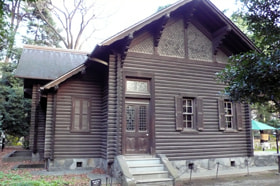

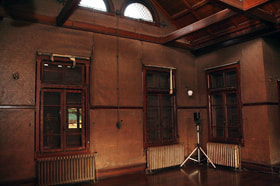
Billiard room in the separate building
This Swiss cottage style wooden building has Azekura style walls and Gothic style big roof with extending eaves.
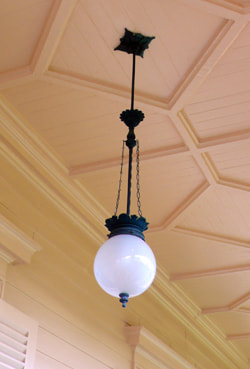
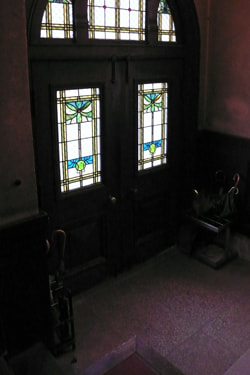
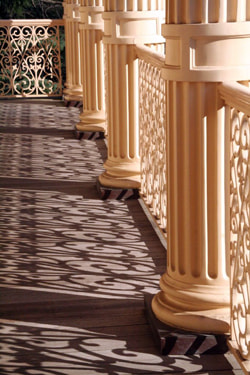
The Ionic order pillars line up in a veranda of the second floor

The Ionic order pillars line up in a veranda of the second floor

Josiah Conder (1852-1920) dressed in kimono
Conder was invited to Japan in 1877, as an architecture teacher at the Imperial College of Engineering (present-day Department of Architecture, the University of Tokyo) and an office advisor for the bureau of the building and repairs in the Ministry of the Engineering. He stayed in Japan until 1920, and designed many buildings, including Rokumeikan Palace. And he educated some famous architects, including Kingo Tatsuno and Kotaro Sakurai, and passed away at the age of 67 in Tokyo.












